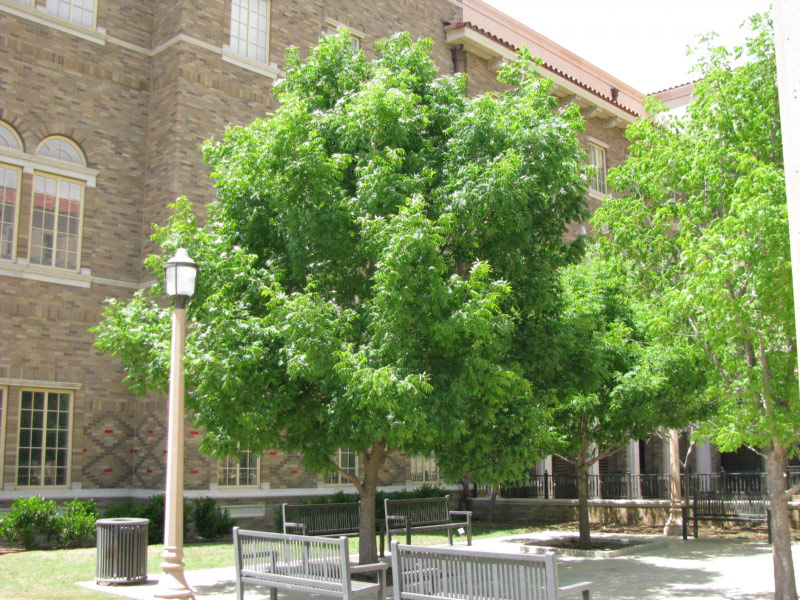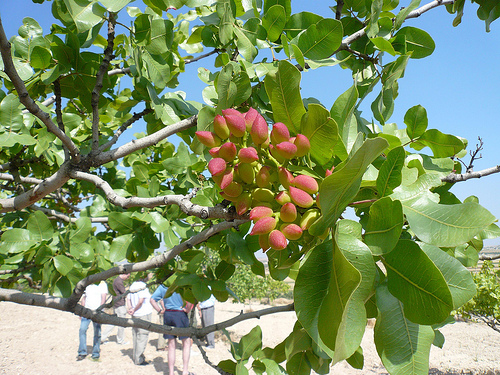Pistachio Tree Biography
Pistachio is a desert plant, and is highly tolerant of saline soil. It has been reported to grow well when irrigated with water having 3,000–4,000 ppm of soluble salts.[5] Pistachio trees are fairly hardy in the right conditions, and can survive temperatures ranging between −10 °C (14 °F) in winter and 40 °C (104 °F) in summer. They need a sunny position and well-drained soil. Pistachio trees do poorly in conditions of high humidity, and are susceptible to root rot in winter if they get too much water and the soil is not sufficiently free-draining. Long, hot summers are required for proper ripening of the fruit.
The Jylgyndy Forest Reserve, a preserve protecting the native habitat of Pistacia vera groves, is located in the Nooken District of Jalal-Abad Province of Kyrgyzstan.
The bush grows up to 10 metres (33 ft) tall. It has deciduous pinnate leaves 10–20 centimeters (4–8 inches) long. The plants are dioecious, with separate male and female trees. The flowers are apetalous and unisexual, and borne in panicles.
The fruit is a drupe, containing an elongated seed, which is the edible portion. The seed, commonly thought of as a nut, is a culinary nut, not a botanical nut. The fruit has a hard, whitish exterior shell. The seed has a mauvish skin and light green flesh, with a distinctive flavor. When the fruit ripens, the shell changes from green to an autumnal yellow/red, and abruptly splits part way open (see photo). This is known as dehiscence, and happens with an audible pop. The splitting open is a trait that has been selected by humans.[10] Commercial cultivars vary in how consistently they split open.
Pistachio is a desert plant, and is highly tolerant of saline soil. It has been reported to grow well when irrigated with water having 3,000–4,000 ppm of soluble salts.[5] Pistachio trees are fairly hardy in the right conditions, and can survive temperatures ranging between −10 °C (14 °F) in winter and 40 °C (104 °F) in summer. They need a sunny position and well-drained soil. Pistachio trees do poorly in conditions of high humidity, and are susceptible to root rot in winter if they get too much water and the soil is not sufficiently free-draining. Long, hot summers are required for proper ripening of the fruit.
The Jylgyndy Forest Reserve, a preserve protecting the native habitat of Pistacia vera groves, is located in the Nooken District of Jalal-Abad Province of Kyrgyzstan.
The bush grows up to 10 metres (33 ft) tall. It has deciduous pinnate leaves 10–20 centimeters (4–8 inches) long. The plants are dioecious, with separate male and female trees. The flowers are apetalous and unisexual, and borne in panicles.
The fruit is a drupe, containing an elongated seed, which is the edible portion. The seed, commonly thought of as a nut, is a culinary nut, not a botanical nut. The fruit has a hard, whitish exterior shell. The seed has a mauvish skin and light green flesh, with a distinctive flavor. When the fruit ripens, the shell changes from green to an autumnal yellow/red, and abruptly splits part way open (see photo). This is known as dehiscence, and happens with an audible pop. The splitting open is a trait that has been selected by humans.[10] Commercial cultivars vary in how consistently they split open.
Pistachio Tree
Pistachio Tree
Pistachio Tree
Pistachio Tree
Pistachio Tree
Pistachio Tree
Pistachio Tree
Pistachio Tree
Pistachio Trees Load For Harvest.AVI
A Day At The Pistachio Orchard








No comments:
Post a Comment